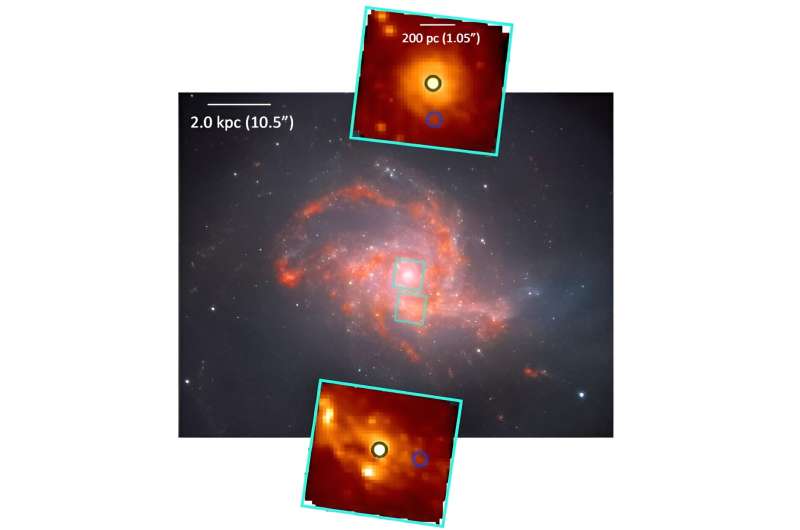April 1, 2024 report
This article has been reviewed according to Science X's editorial process and policies. Editors have highlighted the following attributes while ensuring the content's credibility:
fact-checked
preprint
trusted source
proofread
JWST observations explore molecular outflows of a nearby merging galaxy

Using the James Webb Space Telescope (JWST), an international team of astronomers has observed a nearby merging galaxy known as NGC 3256. Results of the observational campaign, presented March 21 on the pre-print server arXiv, yield essential information about molecular outflows of this galaxy.
NGC 3256 is a starburst galaxy located some 122 million light years away in the constellation Vela. It is composed of two gas-rich disk galaxies in a late-stage major merger and is one of the most luminous nearby systems.
NGC 3256 shows a complex and tidally disturbed morphology, with significantly distorted spiral arms and prominent dust lanes. Previous observations have found that the galaxy has two nuclei: an optically unobscured northern nucleus with signs of starburst activity and a southern heavily obscured, low-luminosity nucleus or a nascent active galactic nucleus (AGN). Moreover, molecular hydrogen outflows originating from these nuclei have been detected.
A group of astronomers led by Thomas Bohn of Hiroshima University in Japan has recently investigated these outflows in NGC 3256, in order to assess their kinematics and energetics, and to evaluate their impact on the local interstellar medium (ISM). For this purpose, they employed JWST's Near-InfraRed Spectrograph (NIRSpec) and Mid-Infrared Instrument (MIRI).
"With JWST, we can now perform the most detailed, spatially resolved analysis of outflowing warm H2 gas to date in NGC 3256. The unprecedented spatial resolution of JWST enables us to examine the warm H2 component on scales of ∼40–100 pc," the researchers wrote.
The observations detected warm, outflowing gas of molecular hydrogen in a collimated outflow originating from the southern nucleus. However, no significant outflowing gas of molecular hydrogen originating from the northern nucleus has been identified.
The outflows from the southern nucleus extend out to a distance of about 2,300 light years, and have a deprojected maximum velocity of approximately 1,000 km/s. The emission was found to be most intense near the far edges of the outflows.
The astronomers calculated the outflowing warm molecular hydrogen gas mass, which was found to be 890,000 solar masses, and the warm to cold mass fraction turned out to be about 4%. The outflow time scale was estimated to be 700,000 years, and the warm outflow mass rate was calculated to be at a level of 1.3 solar masses per year.
Furthermore, the study found that a larger fraction of warmer gas is present near the southern nucleus, which decreases with the increasing distance from the nucleus. According to the authors of the paper, this suggests that the southern nucleus is the heating source of the outflowing gas.
The research also found that the outflow of NGC 3256 is energizing star-forming regions, possibly as a shock. However, the astronomers added that the outflowing gas is not having a clear negative feedback effect on the local star formation.
More information: Thomas Bohn et al, GOALS-JWST: The Warm Molecular Outflows of the Merging Starburst Galaxy NGC 3256, arXiv (2024). DOI: 10.48550/arxiv.2403.14751
Journal information: arXiv
© 2024 Science X Network




















